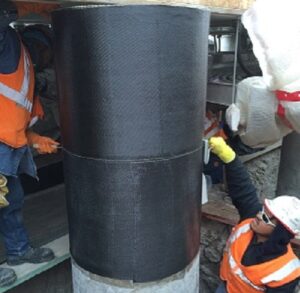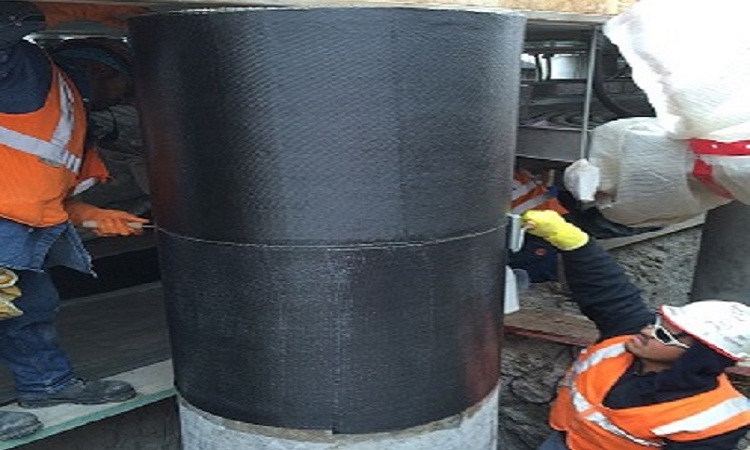What is Carbon Fiber Reinforced Polymer?
Carbon fiber reinforced polymer(CFRP) are composite materials that rely on the carbon fiber to provide the stiffness and strength while the polymer provides a cohesive matrix to protect & hold the fiber together and provides some toughness.
Carbon fiber reinforced polymer (CFRP) are manufactured as strips, bars and sheets using different production technique like filament winding, pultrusion, and hand lay-up process.
Carbon fiber reinforced polymer (CFRP) materials possess good rigidity, high strength, low density, corrosion resistance, vibration resistance, high ultimate strain, high fatigue resistance & low thermal conductivity. They are bad conductors of electricity and are not-magnetic.
The carbon fiber-reinforced polymer (CFRP) provides for many problems associated with the deterioration and strengthening of infrastructures such as bridges and buildings. Using carbon fiber reinforced polymer reinforcing bars in new concrete can eliminate potential corrosion problems and sustainability increase the structural strength of the member.
Effective use of carbon fiber reinforced polymer could significantly minimize the maintenance requirements & increase the life of structures. Carbon fiber has also been used as reinforcement for ablative plastics & for reinforcement for lightweight, high strength, and high stiffness structures.

Properties of Carbon Fiber Reinforced Polymer
- Carbon fiber reinforced polymer is a bad conductor of electricity and is non-magnetic.
- Carbon fiber reinforced polymer possess high ultimate strain.
- It has low thermal conductivity.
- Alkali resistant.
- It needs a short curing time. Therefore, the application takes a shorter time. This reduces the project duration & downtime of the structure to a great extent.
- Corrosion resistance is why it is used for corrosion control and rehabilitation of the reinforced concrete structure.
- Carbon fiber reinforced polymer has the strength to weight ration and hence it eliminates requirements of heavy construction equipment and supporting structures.
- High fatigue resistance. So, they don’t degrade, which easily alleviates the requirement of frequent maintenance.
- Due to its lightweight, a prefabricated component in carbon fiber reinforced polymer can be easily transported. This thus encourages prefabricated construction; reduces site erection labor cost and capital investment requirement.
Application of Carbon Fiber Reinforced Polymer in Concrete Structures
Carbon fiber reinforced bars
Carbon fiber reinforced polymer bars are currently used to reinforce concrete in an attempt to overcome the corrosion issue encountered with ordinary steel. In order to exploit more efficiency in their tensile capacity, it is interesting to use carbon fiber reinforced polymer bars as prestressing tendons. This application requires a high-quality concrete matrix. The flexural behavior of prestressed concrete members reinforced with carbon fiber reinforced polymer bars is highly dependent on the bond between the two materials.
Carbon fiber reinforced polymer has been in the construction of new building & strengthening reinforced concrete structures using near-surface mounted carbon fiber reinforced polymer reinforcement technique.
Carbon fiber reinforced polymer laminates
Low thermal expansion carbon fiber reinforced polymer laminates are used for strengthening of structural members such s girders in beam and beams in buildings.
Carbon fiber reinforced polymer is used to strengthen steel road bridges more quickly, easily, and cheaply.
Carbon fiber reinforced polymer wraps
Carbon fiber reinforced polymer wrapping is used for the rehabilitation of masonry columns. Carbon fiber reinforced polymer wraps are used for corrosion control and rehabilitation of reinforced concrete columns. Carbon fiber reinforced polymer wraps are also used for the construction of earthquake-resistant structures.
The addition of carbon fiber reinforced polymer sheets greatly increases the ultimate flexural moment capacity of the retrofitted shear wall. However, in order for the fiber-reinforced polymer sheet to carry the high axial loads resulting from the bending moment imposed on the shear wall, the carbon fiber reinforced polymer sheets must be adequately anchored at the base of the wall.

Carbon fiber reinforced strips
There are many techniques that use carbon fiber reinforced polymer strips, laminates for strengthening concrete structures such as externally bonded carbon fiber reinforced polymer sheets and near-surface mounted fiber-reinforced polymer. The performance of the strengthening methods depends on the strength of the adhesive used to bond carbon fiber reinforced polymer to the concrete surface and the degree of stress at the interface of the concrete and carbon fiber reinforced polymer.
Carbon fiber reinforced polymer is used to strengthen steel road bridges more easily and cheaply. The carbon-fiber-reinforced polymer strips are only 20% of the weight of the strips of similar products made from the high-strength sheet but are at least four times as strong. Their high-strength-to-weight ratio makes the carbon fiber reinforced polymer strips easily to handle and reduces installation costs. Strips of carbon fiber reinforced polymer measuring just 8 mm in thickness have been used to strengthen a road bridge in Rochdale, UK.
Advantages and Disadvantages of Carbon Fiber Reinforced Polymer
Advantages of Carbon Fiber Reinforced Polymer
Tensile Strength
The tensile strength of carbon fiber reinforced polymer is 10 times as high as that of ordinary steel.
Modulus of elasticity
The modulus of elasticity is higher than the steel and the modulus of elasticity of aramid fiber and glass fiber composites is only half and ¼ of the steel.
Light Weight
Carbon fiber reinforced polymer is a low-density material with a very high strength to weight ratio.
High corrosion resistance
Rust is as iron oxide, mainly formed by the reaction of water or moisture in the air with iron. Carbon fiber reinforced polymer does not have any iron content, hence they do not form rust.
Higher strength-to-density ratio
The carbon fiber reinforced polymer composites are of higher strength-to-density ration compared to aluminum alloy and steel.
Fatigue strength
The carbon fiber reinforced polymer composites are naturally more fatigue resistance than the traditional strengthening materials like steel or concrete. Fatigue happens by the propagation of microcracks as a result of cyclic or repeated loading. During cyclic loading, in traditional strengthening materials like steel and concrete, the propagation of microcrack in much faster than the carbon fiber reinforced polymer composites. It is made of numerous individual carbon fiber which prevents micro-crack propagation as they do in traditional strengthening materials.
Low thermal expansion
Thermal expansion refers to the tendency of the objects to expand and contract depending on the temperature of the environment. Low thermal expansion contributes to the sustainability of materials. Materials with low thermal expansion are appropriate in cases when the small changes of position matter. While the thermal expansion of steel 7-inch degree F, one of the carbon fiber reinforced polymer hovers around -1 to 8 degrees. Depending on the type of fiber and method of manicuring carbon fiber reinforced polymer can be exceptionally stable.
Application flexibility
Thick steel plates are generally limited in length, difficult to place in curve surface and also due to its heaviness, handling is difficult. In contrast, carbon fiber reinforced polymer is 25 m in length. Due to its lightweight, handling is very easy. It can be wrapped in many layers depending on the strength required. Wrapping can be done without the need for heavy equipment or machinery.
Density
The density of carbon fiber reinforced polymer composites is 1.6 times lesser than aluminum alloy and 4.4 times lesser than steel.
Disadvantages of Carbon Fiber Reinforced Polymer
High Cost
Carbon fiber reinforced polymer composites are expensive as compared to structural steel and aluminum alloy. It can be nearly two hundred times more expensive than structural steel and nearly one hundred times than aluminum alloy. The cost difference is very high when it is compared to steel and aluminum alloy.
Conductivity
Carbon fiber reinforced polymer composite is both thermally and electrically conductive. But carbon fiber composite doesn’t change size with temperature, unlike steel or aluminum alloy.

